
Бесплатный фрагмент - Comprensive Optimization Decisions Exchange Traders
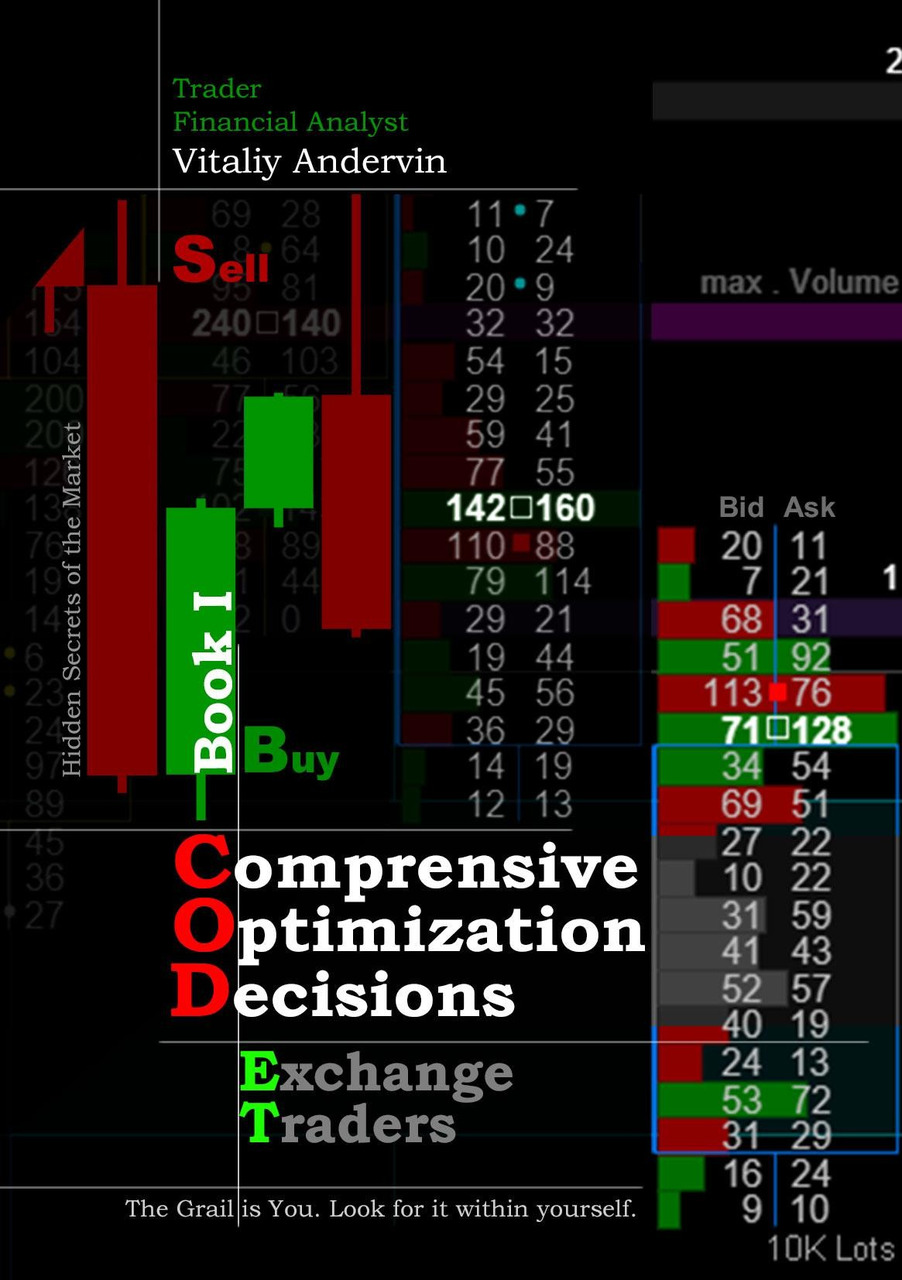
Comprensive Оptimization Decisions
© BT. 2024. Vitaliy Andervin
Introduction
Trading is an exhilarating journey into a world where success is achieved through a deep understanding of market mechanisms and the ability to interpret data. In an era of rapidly changing financial markets, it is precise and timely decisions that are decisive. But to make them, you need to learn not just to follow the charts, but to see what lies beyond the obvious.
A modern trader has a vast array of analytical tools at their disposal: quotes, volumes, delta, limit orders, heatmaps, and much more. However, an abundance of data can be both an advantage and a source of confusion. Only those who can find order in the chaos of market movements gain a real advantage.
This book is designed to help you master the art of reading market data. You will learn how to understand the logic of volumes, understand the work of delta, evaluate the behavior of limit orders, and see hidden signals in heatmaps. Together, we will delve into the intricacies of market analysis, step by step revealing to you all the richness of the trader’s tools.
Why is it important to study market data?
The financial market is a field where every participant strives to achieve their goals. Some aim to protect their assets, while others seek to make a profit. Large funds, algorithmic systems, and retail traders all leave their “traces” in market data.
These traces can reveal:
— Where major players are accumulating positions.
— Which levels act as support or resistance.
— When the price is preparing for a reversal or continuation of its movement.
— Which movements are manipulations and which reflect the true market sentiment.
By studying the data, you gain access to the “language of the market,” which helps you understand what is really happening behind the visible price movements.
What Awaits You in This Book
This book will be your guide to the world of market data.
Inside, you will find:
— Simple and accessible explanations of complex concepts.
— Real market examples to help reinforce theoretical knowledge.
— Practical tips for building effective trading strategies. We will cover:
— Volumes: How to understand market activity through volume analysis.
— Delta: How to distinguish the strength of buyers and sellers.
— Limit Orders: Their impact on liquidity and price movement.
— Heatmaps: How to interpret data on limit orders. Low Liquidity Areas:
— How to use these zones to identify entry and exit points.
— Each chapter combines theory and practice, enabling you to immediately apply the knowledge gained to real market scenarios.
Your Path to Professional Mastery
This book is just the beginning of your journey. Here, we lay the foundation for a deeper exploration of market mechanisms.
In the second book, we will delve into the intricacies of market data — a powerful tool that reveals the inner structure of market interactions. We will cover how to analyze orders, the tape of prints, limit trades in the order book, and more.
The third book will bring everything together, helping you craft comprehensive trading strategies tailored to any market condition.
About the Author
Vitaliy Andervin is a trader for whom the market has become more than just a profession. He believes trading is an art where every trade demands an understanding of the market’s underlying mechanisms. For over a decade, he has applied and analyzed market data, specializing in volumes, delta, and limit orders.
Vitaliy is convinced that success in trading is achieved not through automated systems but through conscious understanding of market data and precise decision-making. His methodology helps traders of all skill levels view the market from a new perspective.
Let this book be your first step into the world of professional trading. Learn, apply, practice. Each new skill brings you closer to success, and the market always opens new opportunities for those ready to seize them. Good luck on this journey!
Contents
Chapter 1: Fundamentals of Market Data
— Volumes and Their Importance
— Delta as an Indicator of Strength
— The Role of Market Orders
Chapter 2: Price Level Details and Market Data
— Volume and Its Interpretation
— The Impact of Ticks and Time Intervals
— Levels of High Interest
— Aggregated and Staggered Trades
Chapter 3: Volume and Delta Profiles
— Horizontal Volume Profile
— Vertical Volume Profile
— Horizontal Delta Profile
— Vertical Delta Profile
Chapter 4: Limit Orders as a Component of Market Data
— Introduction to Limit Orders and the Order Book
— Gradation of Limit Orders
— Heatmap of Limit Orders
— Low Liquidity Zones
— Practical Use of Limit Orders
Conclusion
Summary of Market Data Insights
Preparation for Footprint Analysis in Future Books
Chapter 1: Footprint as an Analysis Tool
The world of trading is about choosing the right tools, approaches, and data for analysis. Some traders rely on technical analysis: patterns, trendlines, and indicators. Others seek a deeper understanding of market structure through data analysis.
The footprint chart reveals the hidden dynamics of the market and the intentions of its participants. It is a mirror of the market process. Each trade is part of a larger picture, displaying the balance between buyers and sellers, key levels of activity, and significant changes.
Unlike technical analysis, which is based on historical data, the footprint chart provides an accurate view of the current situation. While technical analysis offers a broad overview, the footprint chart delivers details. It’s like art: some see brushstrokes, others notice textures.
The market is a battle for profit. The footprint chart helps you see the process, understand market logic, and make decisions when all factors align.
Section 1: What is a Footprint Chart Definition of a Footprint Chart:
— A footprint chart is a visualization of market trades, showing how many contracts were executed at a given price at a specific moment.
— It separates trades into Bid (sales) and Ask (purchases).
Role of the Footprint Chart in Analysis:
— Identifying accumulation and distribution zones.
— Assisting in determining market sentiment and activity.
Section 2: Types of Footprint Data Volumes at Price Levels:
— The total number of trades at a specific price.
— Identifying key support and resistance levels.
Bid and Ask Balance:
— Comparing buyer and seller activity.
— Determining the dominant side of the market.
Delta Within the Footprint:
— The difference between purchases and sales at each level.
— How delta helps uncover hidden volumes.
Section 3: Practical Applications of the Footprint Chart
Accumulation and Distribution Zones:
— How to identify areas where large players are building or unloading positions.
— Examples of analyzing zones of high activity.
Detecting Manipulations:
— Using the footprint chart to identify “false moves.”
— Recognizing artificial price holding.
Trend and Reversal Analysis:
— How the footprint chart helps identify the start or end of a trend.
— Examples of analyzing reversal patterns.
Section 4: Examples of Data Visualization Reading Footprint Charts:
— Step-by-step explanation of chart structure.
— Examples of analyzing volumes and delta on a footprint chart.
Data Interpretation:
— How to accurately read Bid/Ask data.
— Analyzing real chart examples.
Real-Time Footprint Analysis:
— Configuring a platform for analysis.
— How to use the footprint chart for immediate decision-making.
Section 1: What is a Footprint Chart
Immerse yourself in the world of footprint charts — a tool that unveils the true structure of the market. It’s more than just visualization: the footprint chart is an X-ray of trade flows, revealing what standard charts cannot show.
The footprint chart organizes market data streams, displaying volumes, prices, and the balance of supply and demand at each level. Each element of the chart tells a story: some market participants defend their positions, others attack, and still others seek opportunities to enter the game.
What happens at each price level? How do buyers and sellers interact?
With the footprint chart, these questions are no longer a mystery.
You will learn to identify:
— Precise trading volumes: pinpointing areas of accumulation and distribution.
— Market sentiment: determining which forces — buyers or sellers — are dominant.
— Key zones of activity: levels where major players are active.
The footprint chart opens the path to conscious understanding of market processes for traders. It’s the language of the market, enabling you to forecast price movements, observe the actions of major players, and recognize moments when the market is ready to reverse or continue its trend.
This section will serve as the foundation for mastering the footprint chart as a key analytical tool. Welcome to a world where every trade tells a story!
Definition of a Footprint Chart
The footprint chart provides traders with a unique analytical tool, offering a clear view of market activity by breaking down trades into buy (Ask) and sell (Bid) orders. This approach gives deeper insight into who is dominating the market at any given moment.
Segmentation of Trades into Bid and Ask
The footprint chart visually displays the balance between supply and demand, enabling traders to quickly assess the market situation.
Buy Trades (Ask):
— Green values on the footprint chart represent the volume of buy trades. These occur when buyers accept the sellers’ price.
— For example, at the price level of 1.0570, the Ask volume is 526 contracts, signaling significant buyer interest.
Sell Trades (Bid):
— Red values on the footprint chart indicate the volume of sell trades. These occur when sellers accept the buyers’ price.
— For instance, at the price level of 1.0564, the Bid volume is 350 contracts, pointing to active seller dominance.
Example of Footprint Data Interpretation
The following illustration shows data where each row corresponds to a specific price level with displayed volumes:
— At the price level of 1.0572, the Ask volume is 472, while the Bid volume is 152. Buyers exhibit dominant influence.
— At the price level of 1.0564, the Bid volume is 350, exceeding the Ask volume of 287, indicating seller pressure.
Importance of Analysis
Color Coding:
Green values represent buy volumes, while red values indicate sell volumes. This visual differentiation makes it easy to quickly determine who controls the market.
Key Levels:
High Bid and Ask volumes often highlight zones of support or resistance. For instance, significant volumes at the 1.0564 level could signal the formation of resistance.
The footprint chart makes the market more transparent, helping traders identify where buyer and seller activity is concentrated. With this tool, traders can develop more informed strategies, avoiding false signals and speculative assumptions.
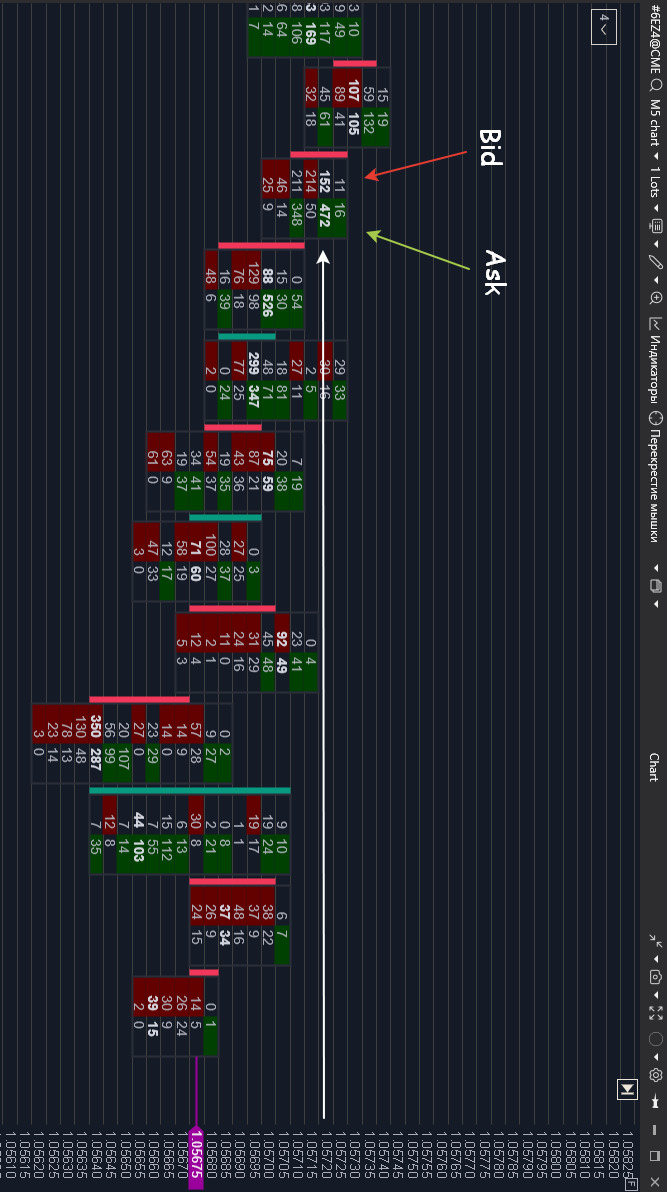
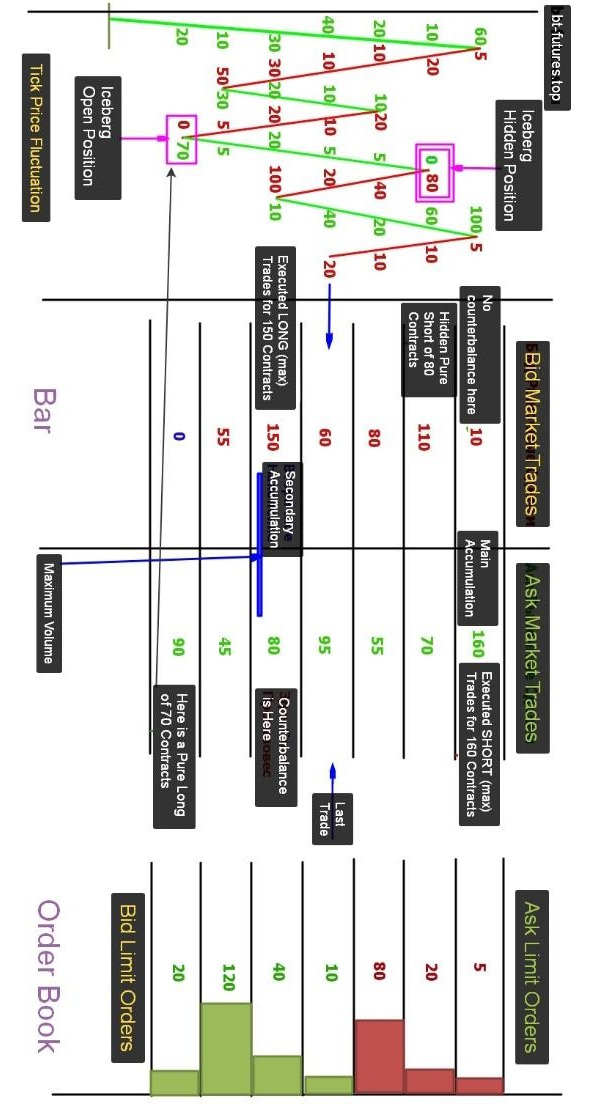
The footprint chart stands out among other analytical tools for its ability to deeply visualize market data. This enables traders to see the distribution of trades across price levels, identify key activity zones, and make more informed trading decisions.
The presented image highlights essential elements of analysis, such as market and limit orders, iceberg positions, and accumulation levels. Each of these elements helps to understand the dynamics of market forces, identify critical levels, and determine the balance between buyers and sellers.
Key Elements of the Image
Tick Price Fluctuation (Left):
This chart shows the price movement within a single bar:
— Green lines indicate price increases, while red lines reflect price decreases.
— Accumulations at key levels are visible on the chart, revealing where the market “fills up” with volumes. For instance, at the 70 level, trades linked to an “Iceberg Open Position” are recorded.
Bar Structure (Center):
The footprint chart clearly visualizes the volumes of market trades:
— Level 100: Recorded 160 Long contracts, marked as “Main Accumulation.” The absence of counterbalance enhances the importance of this level.
— Level 150: Volume of 150 Short contracts. The presence of a counterbalance of 80 Long contracts reduces the significance of this level.
Order Book (Right):
Limit orders are visualized as colored blocks:
— Red blocks represent sell limit orders (Ask).
— Green blocks represent buy limit orders (Bid).
Examples:
— Level 120: Limit buy orders total 120 contracts, potentially indicating a support zone.
— Level 80: Limit sell orders of 80 contracts create a resistance level.
—
Accumulation Levels:
— Primary Accumulation (Level 100):
160 Long contracts. Here, sell limit orders are fully executed, confirming the importance of the level.
— Secondary Accumulation (Level 150):
150 Short contracts, but a counterbalance of 80 Long contracts reduces the significance of the level, even with the presence of “Maximum Volume.”
Iceberg Positions:
— Iceberg Hidden Position (Level 80):
Hidden trades often used by large players to disguise their intentions.
— Iceberg Open Position (Level 70):
Visible trades that can distract and mislead other market participants.
Significance of Visualization
— This image illustrates how footprint analysis enables traders to:
— Identify key market levels where buyers or sellers dominate.
— Recognize false signals, such as “Iceberg Open Positions,” and uncover genuine intentions hidden behind “Iceberg Hidden Positions.”
— Evaluate the balance of power between supply and demand.
— Differentiate critical levels (e.g., without counterbalances) from artificially created points like “Maximum Volume.”
Using footprint data helps traders avoid market traps and make decisions based on facts rather than assumptions. It is a tool that minimizes risks and increases the chances of success.
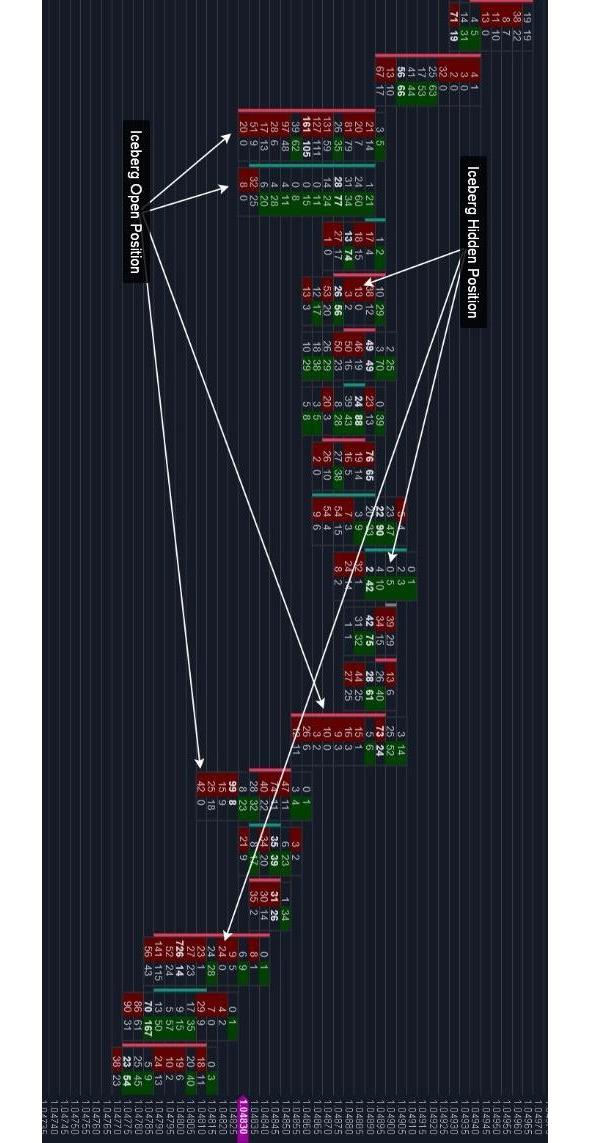
The Role of Footprint in Analysis
— Accumulation Zones
Accumulation zones represent key market areas where trading volumes concentrate within a narrow price range. These zones often occur during periods of uncertainty when major market participants accumulate positions while avoiding significant price changes.
Understanding the structure of such zones helps traders navigate the current market situation and predict future movements.
Key Characteristics of Accumulation Zones
High Activity at Levels
Increased trading volumes on both Bid (sell) and Ask (buy) sides indicate heightened interest from market participants at these levels.
Narrow Price Range
The price moves within a confined range, signaling consolidation of interests and the absence of dominance by either side.
Volume Balance
Bid and Ask volumes remain relatively balanced, demonstrating equilibrium between buyers and sellers. This balance persists until major players trigger a significant price movement.
Practical Application of Accumulation Zones
Identifying Reversal Points
Accumulation zones often act as precursors to reversals or the start of new trends. Analyzing these zones allows traders to identify optimal entry or exit points in the market.
Revealing Intentions of Major Participants
High trading volumes within a narrow price range indicate hidden actions by large players. Understanding their strategies helps avoid false signals and unwarranted risks.
Example on the Chart
The provided chart highlights accumulation zones:
Areas with high volume activity, marked by yellow and green frames, indicate interest from both buyers and sellers.
The narrow price range demonstrates moments of consolidation, where the price “stalls” before making a significant move.
Balance between Bid and Ask volumes (e.g., 211 on Bid and 296 on Ask) reflects equilibrium between supply and demand.
Accumulation zones offer traders a powerful tool for in-depth analysis of the current market situation, increasing the likelihood of successful market entries.
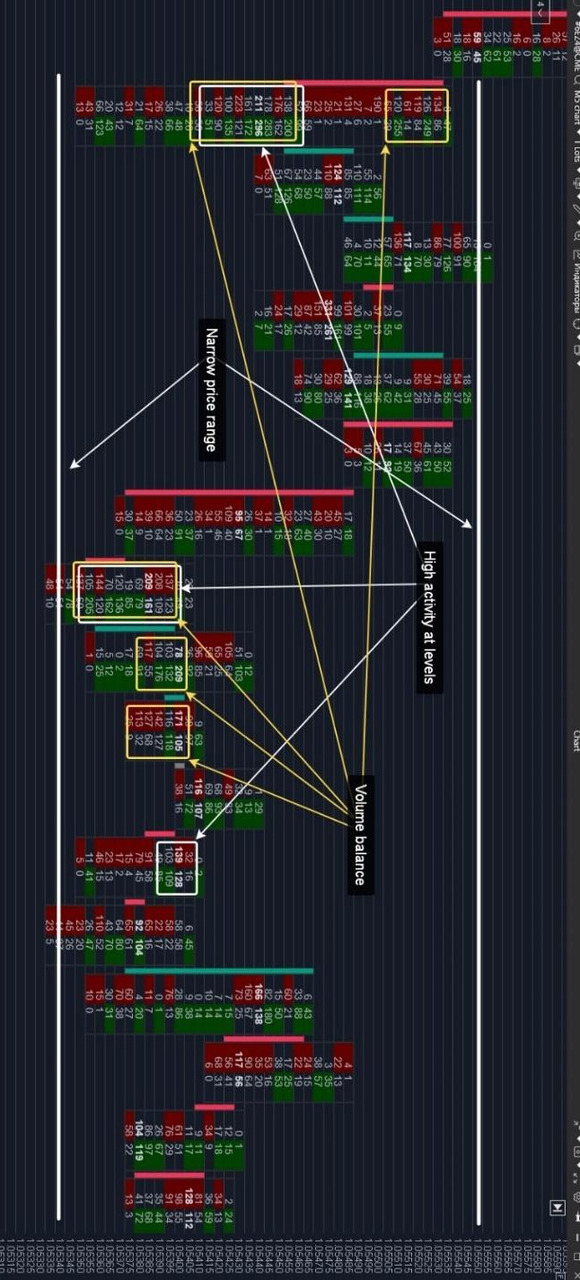
Distribution Zones
What Are Distribution Zones
Distribution zones are key market areas where major participants take profits, close their positions, or reverse the price direction. These zones act as indicators of significant market changes and signal the market’s readiness for further movement.
Key Characteristics of Distribution Zones
— Sharp Volume Changes
Initially, trading volumes increase, reflecting the activity of large players, and then drop sharply, indicating the completion of distribution operations.
— Breakout of the Level
The price moves out of the consolidation zone, accompanied by significant volumes, confirming the market’s readiness to develop a new trend.
— Volume Imbalance
A clear dominance of buy (Ask) or sell (Bid) orders demonstrates the prevalence of one side, becoming a critical factor in forming a new price movement.
Practical Application of Distribution Zones
— Trend Evaluation
Analyzing distribution zones helps traders assess the likelihood of a trend continuation or reversal, reducing the risk of making erroneous decisions.
— Confirmation of Large Players’ Activity
Using footprint data, traders can observe trading volumes within the zone, identifying the true intentions of major participants.
— Reduction of False Signals
Distribution zones, combined with breakout levels, lower the chance of entering trades based on false movements.
Integrating Footprint into Analysis
The footprint provides a clear view of trading volumes within each zone, making the analysis of distribution zones more accurate and effective.
— The presented chart demonstrates:
Sharp Volume Changes: Highlighted on the lower panel, showing the activity of major participants.
— Volume Imbalance:
Marked areas where Ask volumes significantly exceed Bid, indicating buyer dominance.
— Breakout of the Level:
Indicates the moment the price leaves the consolidation zone, signaling the start of a new trend.
Advantages of Using Accumulation and Distribution Zones
— Risk Reduction
Traders avoid opening positions while the price is in a consolidation zone, reducing the likelihood of entering a false move.
— Optimization of Entry Points
Distribution zones provide clear signals for market entry during the formation of a new trend.
— Improved Trade Management
High activity in distribution zones offers a clear understanding of market sentiment, facilitating the selection of exit points and setting protective orders.
Using distribution zones in combination with the footprint is a powerful tool for traders aiming not only to follow the market but to understand its mechanics, predict movements, and minimize risks.
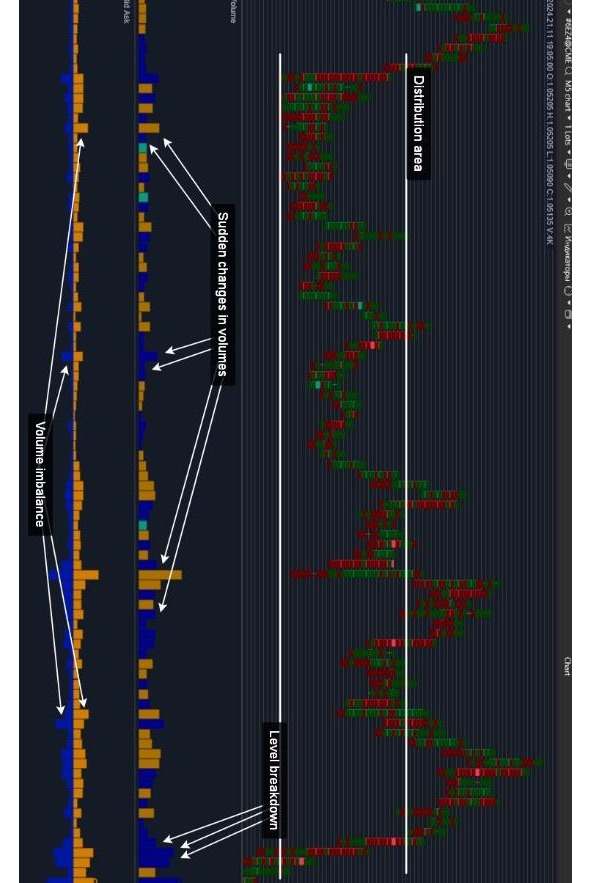
Identifying Market Sentiment
Bid and Ask Analysis
Footprint charts provide traders with a unique opportunity to gain deeper insights into market sentiment by analyzing trade volumes split into buy orders (Ask) and sell orders (Bid). This data segmentation allows traders to identify market participants’ activity and determine which side is dominating at any given moment.
Volume Comparison
High Buy Volume (Ask):
— Indicates buyer initiative, with participants pushing the price upward by actively accepting sellers’ offers.
High Sell Volume (Bid):
— Reflects seller pressure, with market participants controlling the price downward by actively executing buyers’ bids.
Signs of Imbalance
Significant Ask Dominance Over Bid:
— Signals strong buyer interest, with buyers dominating the market, attempting to break resistance and set new price levels.
Significant Bid Dominance Over Ask:
— Indicates substantial seller pressure, with sellers maintaining control and preventing price increases.
Slight Ask or Bid Dominance:
— Suggests a more passive battle between sides:
Slight Ask Advantage: Reflects restrained buyer activity, with buyers not yet ready to drive the market upward.
Slight Bid Advantage: Shows that sellers are holding the price in check without exerting strong pressure.
Application of Sentiment Analysis
Examples of Imbalance on the Chart:
— Significant Bid Dominance: Highlighted at a level with a volume of 754 (Bid) versus 35 (Ask), indicating dominant seller activity.
— Slight Ask Dominance: Identified at a level where buyers are attempting to gain control but have not yet applied noticeable pressure.
This type of analysis helps traders make informed decisions, such as entering the market at levels where one side dominates or waiting for confirmation of activity. Using footprint charts for sentiment analysis reduces the likelihood of false entries, enabling precise assessments of market behavior.
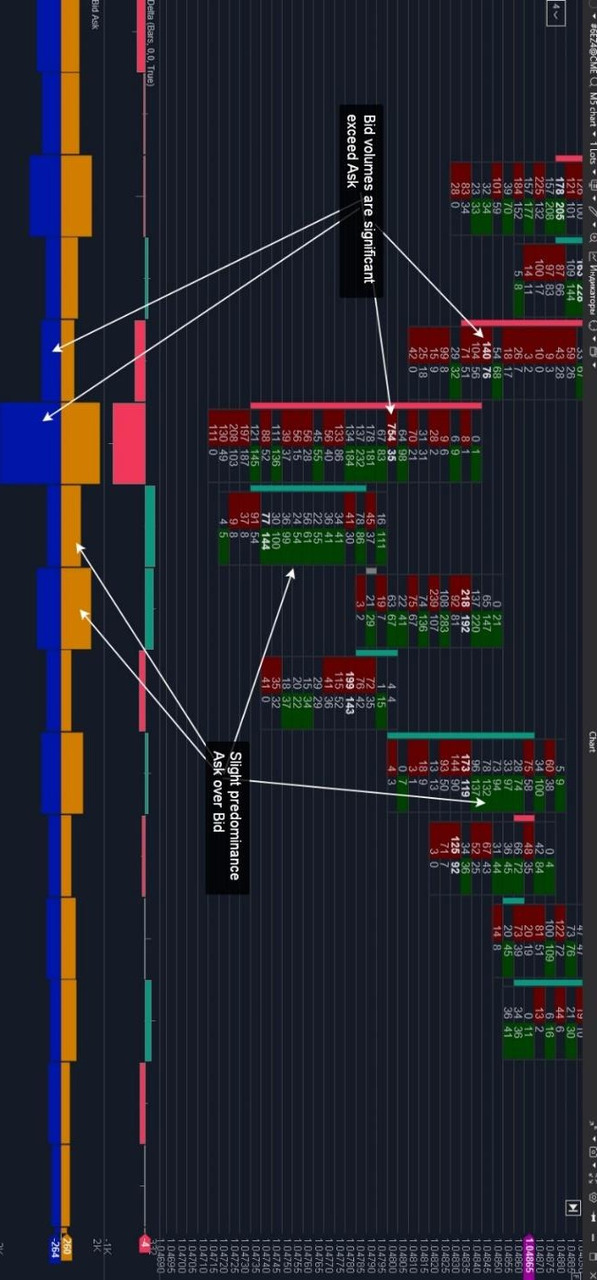
Market Sentiment Signals
The footprint chart is a powerful tool for analyzing imbalances and interactions between market participants at key levels. It enables traders to identify areas where the market is preparing for a breakout, reversal, or continuation of movement.
Key Signals:
Imbalances at Key Levels:
— Sharp Increase in Ask: Indicates buyer pressure. This can signal an impending breakout of resistance.
— Sharp Increase in Bid: Demonstrates seller activity, often preceding a support level breakout.
Absorption and Accumulation:
— High Buyer Activity Without Price Increase: Indicates sellers actively holding the market by absorbing buy orders.
— High Seller Activity Without Price Decline: Suggests buyers are maintaining strong positions, preventing the price from falling.
Counteraction at Levels:
— Bid Dominance at Highs: Reflects seller resistance, signaling readiness to defend the level.
— Ask Dominance at Lows: Demonstrates buyers defending the level, preventing the price from dropping further.
Conclusion
Footprint charts visualize market sentiment, helping traders understand participants’ actions at key levels.
Analyzing signals of imbalance, accumulation, and counteraction enables traders to:
— Identify areas of activity by major market players.
— Detect where the market is preparing for a breakout or reversal.
— Make informed trading decisions, reducing the likelihood of errors.
By leveraging this data, traders gain an advantage that helps minimize risks and improve performance.
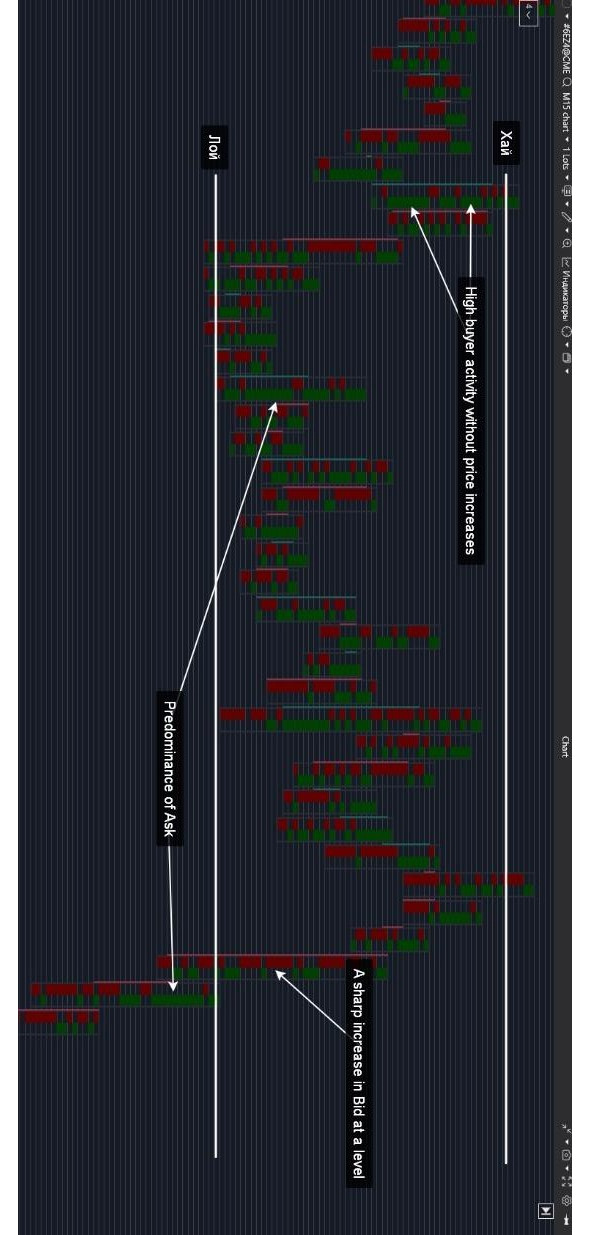



…



Section 2: Types of Footprint Data
Footprint is not just a set of numbers on a chart; it is the key to understanding market dynamics and provides access to the essence of trading processes. This tool allows you to see what is usually hidden: how volumes are distributed, who controls the market — buyers or sellers — and where the real interests of major participants lie.
Every trade, every tick on the footprint tells its own story. These are not just numbers, but real actions of traders: some are actively buying at market prices, others are placing limit orders to restrain price movement, and some skillfully hide their intentions.
What can be seen on the footprint:
Volumes at price levels:
The footprint shows where large volumes are concentrated, helping identify accumulation and distribution zones. These levels often become strong support or resistance.
Bid and Ask:
You can clearly see how many contracts have been bought (Ask) or sold (Bid) at each level. This helps determine who is dominating — the buyers or the sellers.
Delta:
The difference between the Bid and Ask volumes shows which side has the advantage. Delta helps “read” hidden market sentiment, even if the price is currently stationary.
Speed of trades:
During times of increased activity, the footprint helps track volume spikes and determine whether they are the result of real interest or algorithmic activity.
Why footprint is so important for traders:
Trading is a field where the winner is the one who can see just a little more and think ahead. Footprint helps you take your analysis to the next level.
For example:
— If you see large volumes at the 1500 level but the price isn’t rising, it may mean that sellers are actively “absorbing” the buys. This is a signal to avoid entering a long position.
— If, after a breakout, the Bid volumes sharply increase below the breakout point, it signals the entry of large sellers and the beginning of a new trend.
How footprint differs from traditional analysis:
While traditional charts show the result — where the price has gone — footprint reveals the entire process, answering questions: how and by whom this happened.
— Working with major players: Footprint helps identify where “whales” are accumulating or unloading positions.
— Avoiding traps: You can see where the market is creating the illusion of movement and where true intentions are hidden.
— Real data: Every trade, volume, and level on the footprint is actual data, not assumptions.
Conclusion
Footprint is not just a chart; it is your guide to conscious trading. With it, you will learn to:
Identify key levels.
— Define entry and exit points.
— Read market signals and act ahead of the curve.
This tool will allow you to look behind the scenes of the market, understand the actions of major participants, and make informed trading decisions. Ready to be one step ahead? Welcome to the world of footprint and professional analysis!
Volume by Price Levels
Transaction volumes at specific price levels are a key analytical tool for identifying support and resistance zones, as well as for assessing market participants’ behavior. These data allow traders to see where large volumes are concentrated and who is controlling price movement.
What Is Volume by Price Level
— It is the total volume of trades (Bid + Ask) executed at a specific price during a given time period.
— High volumes at a level indicate increased interest from market participants.
— By analyzing who dominates at a level — Bid or Ask — traders can determine prevailing market sentiment.
Key Elements of Visualization
Ask Volumes (Green Cells)
Represent the volume of buy trades where buyers accept sellers’ offers.
Example: At the 1.04356 level, the Ask volume is 696 contracts, indicating buyer activity and making it a potential resistance zone.
Bid Volumes (Red Cells)
Indicate the volume of sell trades where sellers fulfill buyers’ demands.
Example: At the 1.04248 level, the Bid volume is 644 contracts, signaling a potential support zone.
Total Volumes
Display the total number of trades executed at each level.
Levels with high total volumes, such as 1.04248 and 1.04356, suggest significant interest from major market participants.
Practical Significance of Volume Analysis
Identifying Support and Resistance Zones:
Levels with large volumes often become critical points where price may slow down or reverse.
Analyzing Activity:
Color-coded volumes (green for buys, red for sells) make it easier to identify market activity.
Assessing Market Sentiment:
A dominance of Ask volumes over Bid (or vice versa) indicates whether buyers or sellers are in control, helping predict future price movement.
Using volume analysis through a footprint chart provides traders with precise insights into market mechanics, enabling them to identify key levels and effectively manage their positions.
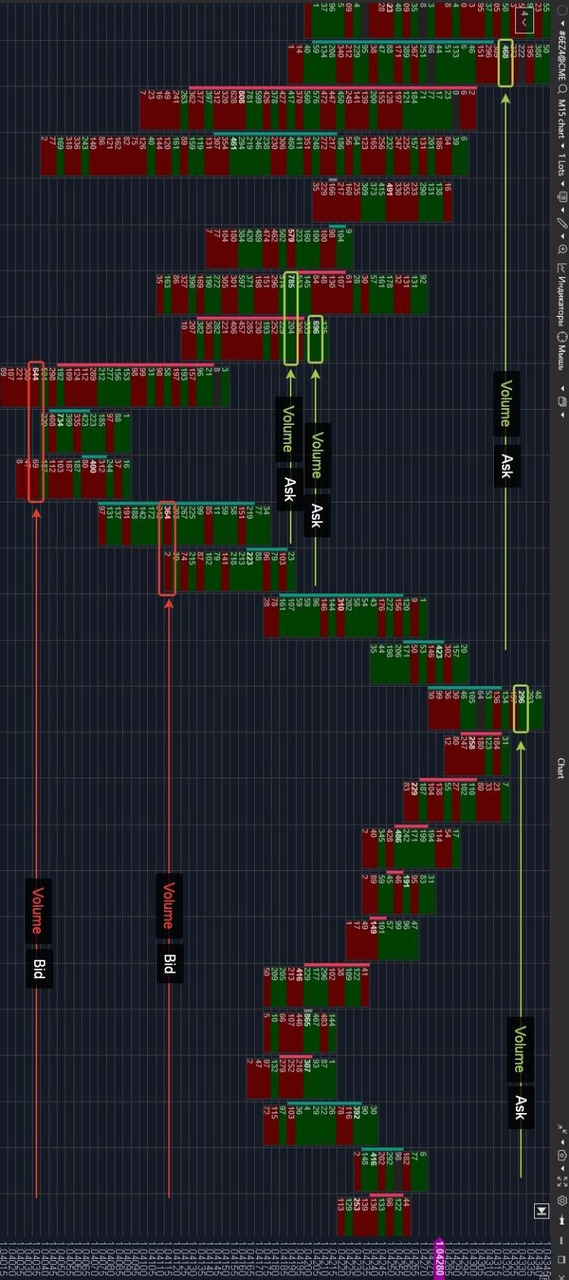
Bid and Ask Balance
Analyzing the balance between buy trades (Ask) and sell trades (Bid) is a crucial tool for understanding market sentiment. This balance allows traders to determine which side — buyers or sellers — is currently dominating.
Comparing Buyer and Seller Activity
— Bid: Sell trades executed at the bid price.
— Ask: Buy trades executed at the ask price.
— Comparing Bid and Ask volumes helps identify market imbalances, indicating which side is in control.
Key Elements of Visualization
— Volumes at Price Levels
Green blocks represent buy volumes (Ask), while red blocks indicate sell volumes (Bid).
Example: At a level with 619 Ask contracts significantly exceeding 166 Bid contracts, buyer activity is evident.
— Comparison of Bid and Ask
Analyzing the volume ratio at different levels:
At levels where Ask exceeds Bid by 1.5 times, strong buying pressure is observed.
These examples are noted across multiple levels, confirming buyer dominance.
— Key Activity Zones
At a level with 470 Ask contracts versus 264 Bid contracts, clear buying dominance is also observed.
Such zones can act as resistance points, where buyers actively prevent the price from falling further.
— Overall Activity Insight
The chart shows evident buyer dominance, as reflected by high Ask volumes at key levels.
This dynamic helps traders understand the current market situation and identify critical levels.
Practical Significance
— Identifying Support and Resistance Zones
High Ask volumes at levels indicate resistance zones where buyers resist further downward movement.
— Assessing Market Sentiment
Imbalances in Bid and Ask volumes reveal which side controls the market.
— Enhancing Trading Strategy
Understanding key activity zones and dominant sides helps avoid false entries and build more precise trading plans.
Using Bid and Ask balance analysis through a footprint chart makes market dynamics more transparent, enabling traders to make informed decisions.
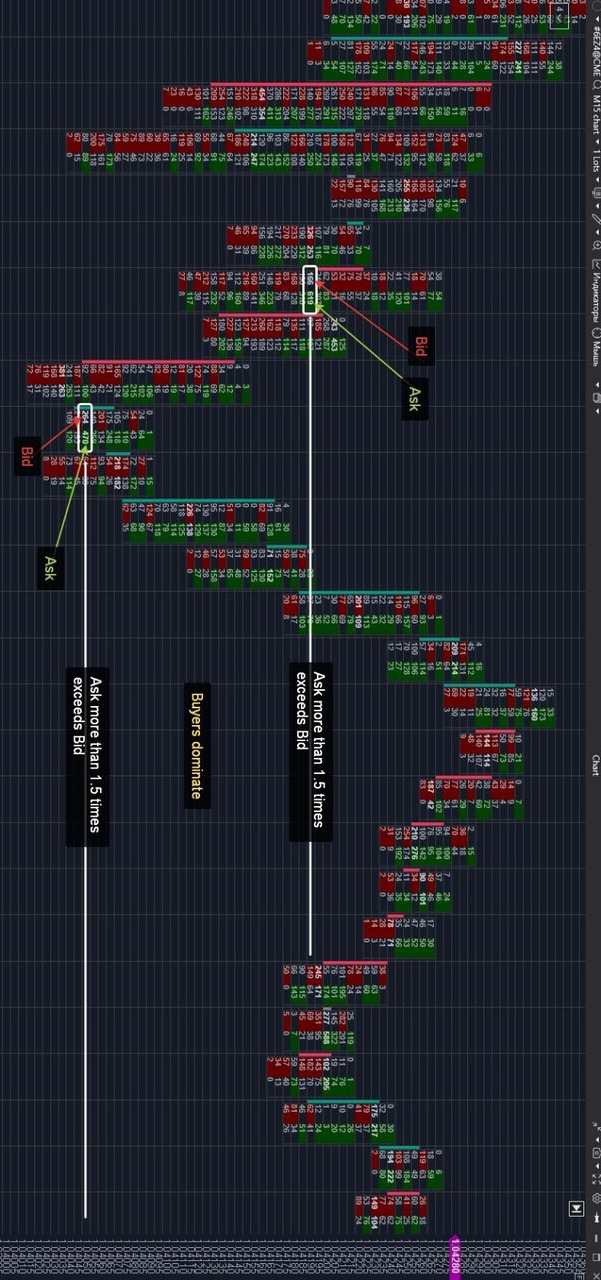
Delta Within the Footprint
Delta is a key metric that represents the difference between buy (Ask) and sell (Bid) volumes at each price level. It helps traders analyze the actions of major market participants and uncover hidden volumes.
What Is Delta Within the Footprint
— Delta represents the difference between buys (Ask) and sells (Bid) at a specific price level.
— Positive delta indicates buying dominance, while negative delta signals selling pressure.
Key Elements of the Visualization
Seller Trap (upper part of the chart)
An area with active selling (Bid), creating the illusion of seller dominance.
Despite high selling volumes, the price does not continue downward. This signals that buyers are absorbing the Bid volumes, forming strong support.
Such a situation can indicate a buying opportunity, as sellers find themselves “trapped” in losing positions.
Buyer Trap (lower part of the chart)
An area with active buying (Ask), where large players artificially stimulate buying interest.
Following this, the price starts to decline, indicating position liquidation by major players and selling pressure.
This is a signal to sell, as buyers are likely to end up in unfavorable positions.
Analysis Examples
At the Seller Trap Level
Bid volumes appear dominant, but the price moves upward, reflecting buyer support.
Such scenarios are often accompanied by actions from major participants forming strong support.
At the Buyer Trap Level
Ask volumes significantly increase, creating the impression of price growth. However, subsequent declines indicate position liquidation by major players.
This is a strong signal of resistance and a shift in market sentiment.
Practical Application for Traders
Identifying Market Traps
Traps help pinpoint areas where the majority of market participants are likely to be in losing positions.
By leveraging these zones, traders can enter the market with reduced risk.
Assessing the Dominant Side
Analyzing the balance of Bid and Ask at trap levels provides insights into which side is controlling the market at the moment.
Building a Strategy
These levels offer clear entry and exit points based on the actions of major market participants.
Conclusion
Using delta analysis through the footprint allows traders to detect market traps, evaluate the dominant side, and make informed trading decisions, minimizing risks.
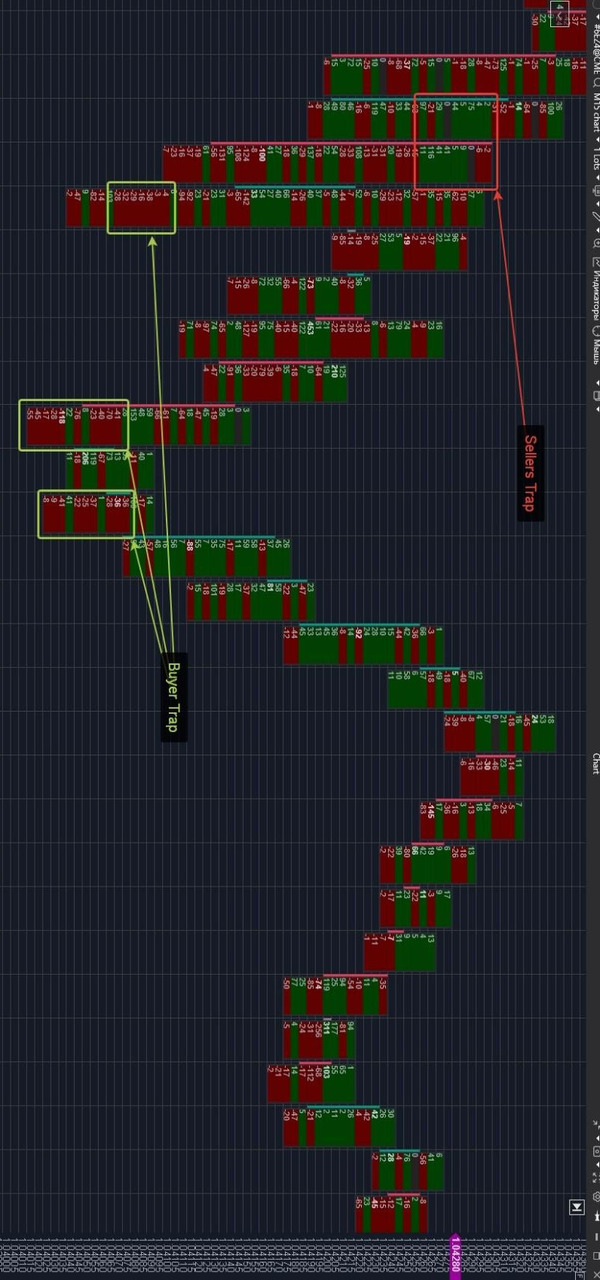



…



.
.
Section 3: Practical Application of the Footprint
Practical Use of the Footprint Chart
The footprint chart is not just a graphical representation; it is a powerful analytical tool that allows traders to delve deeper into market processes. Its value is revealed through practical applications: from analyzing accumulation and distribution zones to identifying manipulations and assessing the current market sentiment. This section will help you master approaches to working with the footprint chart, enhancing the accuracy of your trading decisions.
Accumulation and Distribution Zones
The footprint chart offers a unique opportunity to observe the actions of major market participants accumulating or offloading positions.
These zones are key to forecasting future market movements and provide traders with valuable insights.
Accumulation Zones
What are Accumulation Zones
Accumulation zones form in areas where the price remains within a narrow range while trading volumes increase. This indicates active interaction between buyers (Ask) and sellers (Bid), building a foundation for future market movements.
Characteristics of Accumulation Zones:
— Consistent Bid and Ask activity at key levels, as visible on the chart.
— Prevalence of large trades within a narrow range, often accompanied by a neutral or positive delta.
— Repeated price returns to the same level, signaling consolidation.
Signs of Accumulation Zones:
— High Bid and Ask volumes at specific levels.
— Sustained price movement within a narrow range.
— Neutral or positive delta, indicating balanced forces between buyers and sellers.
Practical Application:
— Traders use accumulation zones to identify entry points. A breakout of these zones’ boundaries typically signals the start of a new trend.
— High-volume levels help identify support or resistance zones where momentum may begin.
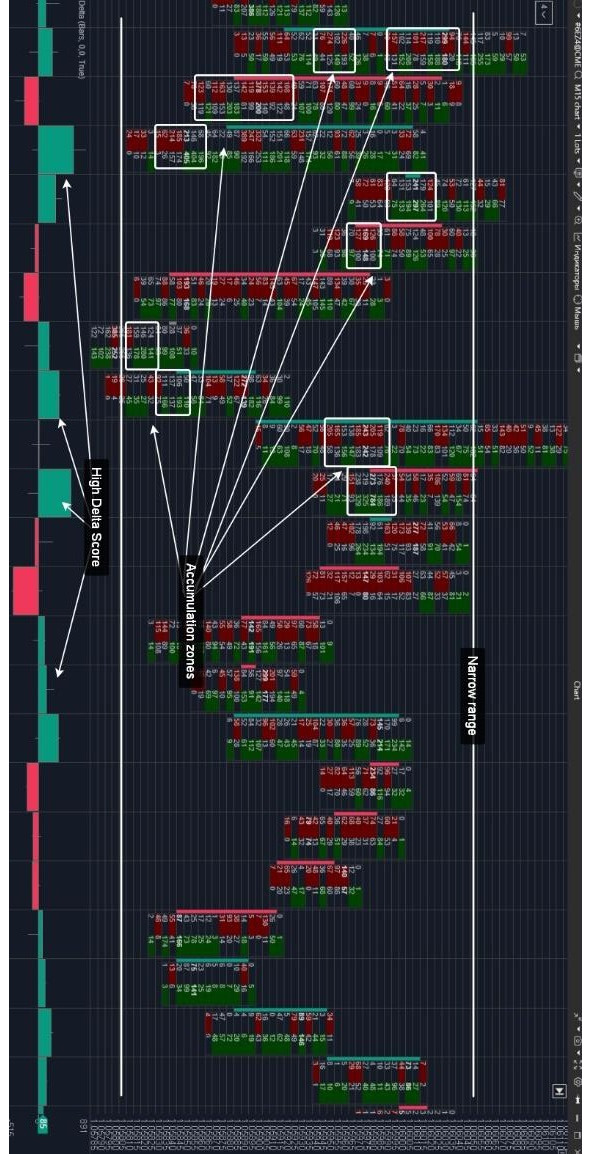
Distribution Zones
What are Distribution Zones
Distribution zones emerge when trading volumes begin to decline, and the price moves out of the previous range. This signals the completion of accumulation and the start of position offloading by major players.
Characteristics of Distribution Zones:
— Gradual decline in volumes following a period of high activity.
— Price movement begins in the direction of the breakout from the narrow range, forming a new trend.
— Often accompanied by a change in delta, indicating a shift in market participant sentiment.
Signs of Distribution Zones:
— Sharp decrease in volumes, signaling waning interest from market participants.
— Breakout of the horizontal range, indicating the end of consolidation.
— Negative delta or a sharp delta shift, confirming a change in participant sentiment.
Practical Application:
Trend Reversal Identification:
Distribution zones help identify moments when an upward or downward movement is coming to an end.
Exit Point Identification:
Declining volumes and delta shifts enable traders to select optimal points for closing positions.
Conclusions and Applications
The footprint chart is a tool that makes the hidden actions of the market visible. Analyzing accumulation and distribution zones allows traders to:
— Identify entry and exit points with reduced risk.
— Understand the actions of major participants and anticipate their influence on price.
— Use delta and volumes to assess market sentiment and identify key levels.
— The practical use of the footprint chart opens opportunities for more accurate and confident trading, helping traders avoid mistakes and minimize risks.
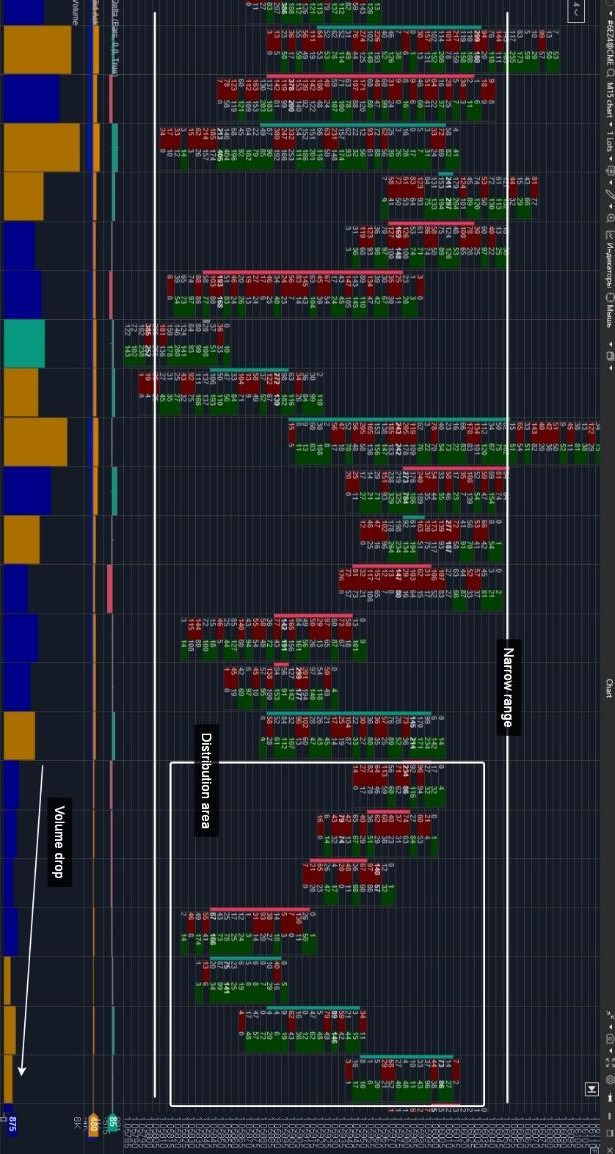
Identifying Manipulations
The Market as a Field of Manipulation
The market is an arena where every participant seeks to gain an advantage. Large players use manipulation as a tool to influence others’ behavior, creating false signals and provoking smaller traders into making mistakes. Footprint charts provide a glimpse behind the scenes of these manipulations, enabling traders to identify and leverage them for their benefit.
What are Manipulations
Manipulation refers to the deliberate distortion of market information to compel other participants into making disadvantageous decisions.
This may involve false price movements, price stalling, or artificially creating an illusion of demand or supply.
Main Types of Manipulations:
— False Moves: Creating an illusion of price intent to move in a certain direction.
— Price Stalling: Artificially stagnating the price at a level for covert accumulation or distribution of positions.
False Moves
What Are False Moves
False moves create an illusion of a market trend, prompting traders to open positions that later result in losses.
Signs of False Moves:
High volumes without significant price movement.
For example, Ask or Bid volumes grow, but the price remains within a narrow range.
Delta contradicting the price direction.
If the price rises while delta remains negative (indicating selling dominance), it suggests a potential trap.
Activity spikes in specific ranges.
These spikes are often used to lure participants to the “wrong” side of the market.
How to Trade It:
— Don’t rush to open positions based solely on price movement.
— Ensure the delta confirms the direction.
— Wait for a breakout from the range with volume confirmation.
Price Stalling
What Is Price Stalling
Price stalling refers to a consolidation phase where large players accumulate or distribute positions while maintaining an appearance of market stability.
Signs of Price Stalling:
Repeated volumes at the same level.
This signals covert activity by major players.
Neutral delta.
If delta remains balanced despite high volumes, it indicates artificial market stalling.
Lack of significant price breakouts.
The price repeatedly returns to the same level without breaking it.
Why Is This Important
— Large players use stalling to covertly prepare positions before a significant move.
— After stalling ends, the market typically makes a sharp move in the “correct” direction.
How to Trade It:
— Analyze repeated volumes and neutral delta.
— Avoid entering trades until the price breaks out of the range.
— Follow the movement confirmed by volumes and delta changes.
Practical Use of Manipulations
Identifying manipulations not only protects traders from errors but also creates opportunities for profitable trades.
How to Use Manipulations to Improve Trading:
Identify Key Levels.
False moves often point to critical support or resistance levels where traps are formed.
Analyze Volumes.
High volume without movement signals manipulation and requires careful analysis.
Use Delta.
Delta shifts help confirm which side of the market has the real advantage.
Conclusions
The footprint chart is your shield and sword against manipulations. It enables you to:
— Recognize traps set for smaller participants.
— Detect covert actions by major players.
— Make informed decisions and avoid impulsive actions.
Golden Rule:
Don’t rush. Analyze volumes and delta to act in alignment with the major players, rather than falling victim to their manipulations.
Trend and Reversal Analysis
— Identifying the Start of a Trend
Footprint charts allow traders to detect early signals of an emerging trend before it becomes apparent to most market participants. This insight helps traders secure a favorable position at the very beginning of the movement.
Signs of a Trend Beginning:
Volume Increase in the Direction of Movement:
— Growing Ask volumes in a bullish trend or Bid volumes in a bearish trend indicate rising market activity.
— A sequential increase in volume is visible on footprint candlesticks.
Delta Dynamics:
— Positive delta in a bullish trend reflects the dominance of buying activity.
— Negative delta in a bearish trend indicates the prevalence of selling.
Large Transactions:
— A sudden surge in volume at key levels suggests activity from major players.
Practical Application:
— Use rising volumes and positive delta to enter a bullish trend.
— Enter the market early, before other traders join the movement.
Identifying the End of a Trend
Recognizing the end of a trend enables traders to lock in profits and avoid losses. Footprint charts help identify key signals indicating a shift in market sentiment.
Signs of a Trend Ending:
Volume Decline:
— A drop in volumes in the trend’s direction signals waning participant interest.
Reversal Delta:
— For example, in a bullish trend, an increase in Bid volume indicates growing seller activity.
Accumulation at Key Levels:
— Large volumes at specific levels suggest major players are closing positions.
Practical Application:
— Secure profits when you notice decreasing volumes and reversal delta.
— Prepare for a reversal by analyzing levels with significant volume accumulation.
Reversal Patterns
Footprint charts help traders identify characteristic reversal patterns, such as “Absorption” and “Trap,” which provide clear signals of a trend change.
Absorption Pattern:
— Description: A sudden surge in opposing volumes (e.g., Bid at the peak of a bullish trend).
— Example: At a local high, significant Bid volume appears, signaling that sellers are absorbing buying activity.
Trap Pattern:
— Description: A false breakout followed by a sharp return.
— Example: The price breaks through a resistance level but then falls back as sellers take control.
Practical Application:
— Use “Absorption” to enter a position in the opposite direction of the current trend.
— Open reversal positions after the “Trap” pattern forms.
Why Footprint Charts Are Indispensable for Trend and Reversal Analysis
Footprint charts reveal the true story of the market by showing:
— Who is in Control: Dominance of Bid or Ask at key levels.
— When a Trend Begins: Early signs of activity from major players.
— When a Trend Ends: Declining volumes and delta shifts.
— How Reversals Occur: Clear reversal patterns with actionable signals.
Trading Recommendations:
— Monitor volumes and delta to enter trends at an early stage.
— Lock in profits when signs of a trend ending emerge.
— Analyze reversal patterns to capitalize on market direction changes.
— Utilizing footprint charts makes trading more precise and informed, reducing errors caused by guesswork or emotions.
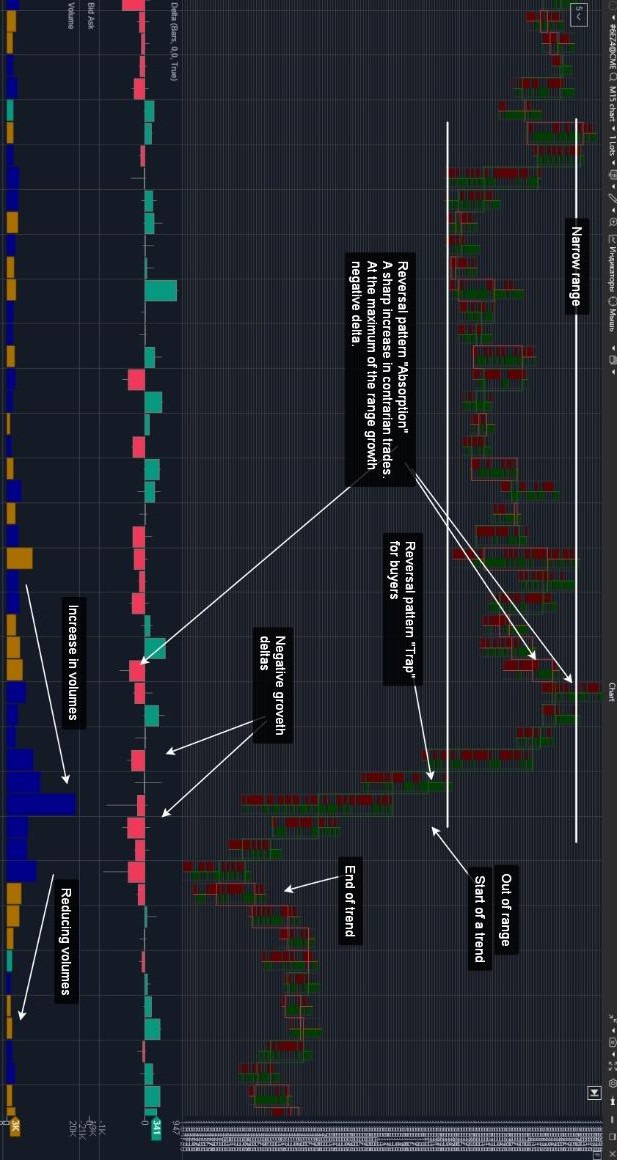
…



…



Section 4: Examples of Data Visualization
The footprint is more than just a tool displaying numbers and volumes. It serves as a comprehensive visual map of the market, revealing the nuances of price movement, volume distribution, and participant activity. Let’s explore how to read footprint data effectively to extract maximum insights for trading decisions.
Reading Footprint Charts: Key Elements and Structure
Each detail on a footprint chart holds significance and serves as a tool for analysis.
Key Elements:
Bid and Ask:
— Bid: The sell trade volume, displayed on the left.
— Ask: The buy trade volume, displayed on the right.
— Example: If at the price level of 1.0433, the Ask volume (296 contracts) exceeds the Bid volume (136 contracts), this indicates buyer pressure.
Total Volume:
— The sum of all trades (Bid + Ask) at a price level.
— Price levels with the highest volume attract significant interest from major participants and often act as potential support or resistance zones.
Delta (Difference between Ask and Bid volumes):
— Positive Delta: Indicates buyer dominance.
— Negative Delta: Indicates seller pressure.
— Example: A delta of -250 at a specific level suggests sellers controlled that level despite the overall volume.
Candle Body:
— Represents the price range over the selected time period:
— A narrow body may indicate consolidation or accumulation.
— A wide body suggests active movement in the trend’s direction.
Transaction Count (Transactions Total):
— Reflects market participant activity. High values at a price level indicate significant interest in that level.
Data Interpretation: Practical Implications
Analyzing Bid and Ask Ratios:
— When the Ask volume significantly exceeds the Bid volume, it signals buyer dominance.
— Conversely, when Bid dominates, sellers are likely in control.
Identifying Zones of Interest:
— Levels with maximum volume often act as critical points where major participants accumulate or liquidate positions.
Delta Dynamics:
— Changes in delta can signal a shift in control between buyers and sellers.
Example:
— A sharp increase in positive delta accompanied by rising volumes is a signal of an emerging uptrend.
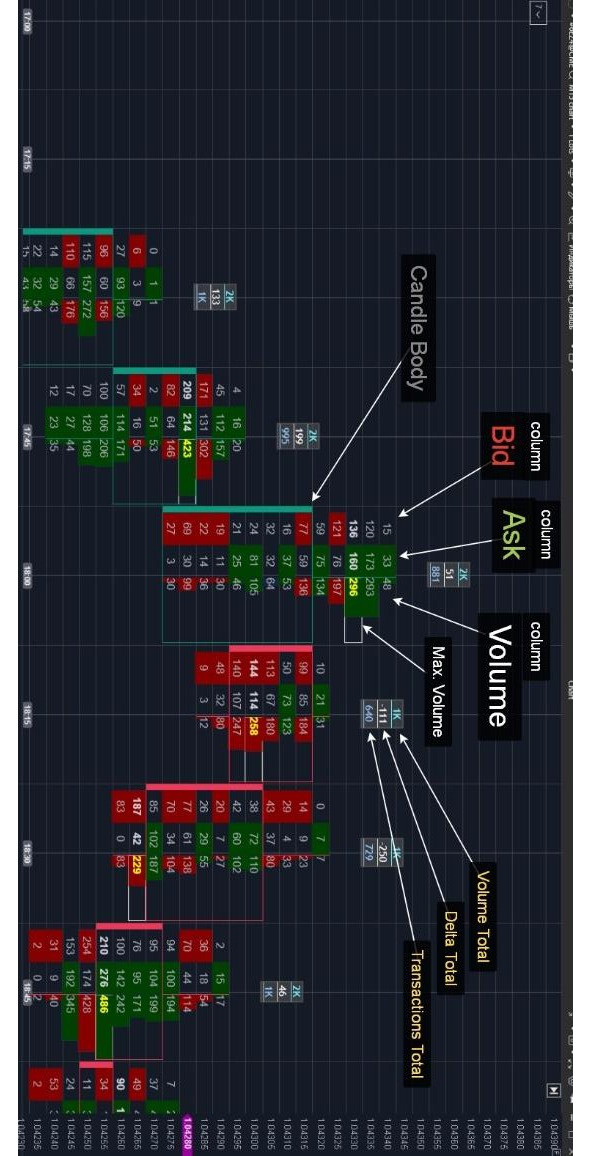
Quick Candle Analysis on the Footprint
Example: Candle 17:45–18:00
Candle Body
— Green body, price increase from 1.0428 to 1.0435.
— Indicates buyer dominance during this time period.
Bid and Ask Volumes
— At the price level of 1.0433:
— Ask: 296 contracts.
— Bid: 136 contracts.
— Ask dominance confirms buyer interest.
Maximum Volume
— Level 1.0433 (296 contracts) is a key zone of interest.
Delta
— Positive (+24) but minor, suggesting weak buyer dominance.
Identifying Manipulations on the Footprint
— False Moves:
— Bid or Ask volumes increase while the price remains within a narrow range.
— This could indicate that major players are attempting to mislead other participants.
Price Holding:
— Repeated high volume at a single level with neutral delta.
— Often signals concealed position accumulation.
Using the Footprint for Decision-Making
— Trend Identification: Rising volumes and consistent delta changes in one direction confirm a trend.
— Finding Accumulation Zones: Levels with narrow price ranges and high volumes often indicate accumulation zones.
— Reversal Signals: A sharp rise in opposing delta and volume changes signal a possible reversal.
— Interpreting High-Volume Levels: If the price stalls at a high- volume level, it indicates a consolidation or resistance zone.
Conclusion
The footprint provides traders with a unique ability to interpret market data with unparalleled detail. Reading the footprint allows traders to:
— Anticipate market movements.
— Understand the actions of major players.
— Identify key support and resistance levels.
Бесплатный фрагмент закончился.
Купите книгу, чтобы продолжить чтение.